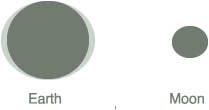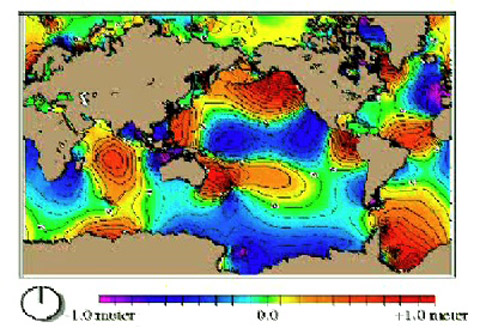© copyright notice ||| français ||| italiano
prologue > prologue on tides > index tides
=============================================================
Itinerary 2.1 - On the current theory on ocean tides.
--- 2.1.#1 ---
Classic representation of the tides.
The tidal wave is a swelling of the water that revolves around the Earth, with a bi-diurnal frequency.
All this is caused above all by the attraction of the Moon, and to a lesser extent by the attraction of the Sun.
Simple descriptions about the tides.
Fig. nr. 1

The attraction of the moon is strongest on the side of the Earth which is facing towards it. Here the above-average pull causes the waters to bulge out toward the moon in a high tide.
At the same time, on the far side of the Earth, the moon's attraction is at it's weakest, and the waters on that side bulge away from the moon, in an equal and opposite high tide.
(source: http://www.the-sea.org/tides.htm)
Combination gravity and inertia.
“... the combination of gravity and inertia create two bulges of water. One forms where the Earth and Moon are closest, and the other forms where they are furthest apart. Over the rest of the globe gravity and inertia are in relative balance. Because water is fluid, the two bulges stay aligned with the Moon as the Earth rotates” (NOAA: Ross, D.A., 1995).
Said by some proponents of the current theory.
Indeed, only if the Earth were completely covered with water, and if its ocean were very deep, the attraction exerted by the Moon and the Sun would produce two bulges of water, one facing the Moon, the other would be found on the opposite side of our planet - as in the figure #1.
--- 2.1.#2 ---
Horizontal component.
The attraction of the Moon would be entirely insufficient to "lift" the water of our oceans - because it is about one 9 millionth part of the force of earth-gravity.
However, while the vertical component is negligeable, the horizontal one has the effective role to attract the waters of seas and oceans westward.
Since the horizontal component is not opposed by the Earth gravity [sic!], the two tidal waves move westbound, from a meridian to the successive one.
In the formula of the horizontal component, the distance is cubed.
--- 2.1.#3 ---
Figure #1 remains the reference.
Still today, he figure #1 remains the current commonplace representation of how ocean tides would work. You can find it everywhere: in textbooks, in tv documentaries, and now in web pages. It is a shame that those who should disseminate knowledge professionally stay put on an old cliché.
Today, even in documentaries, we can see the Earth travelled by two tidal waves, which keep themselves aligned on the position of the Moon, and even in the process of being amplified to make the understanding easier.
Indeed, the image is easy to understand, but it is false when compared to what happens in reality, as will be shown shortly in a NASA film.
--- 2.1.#4 ---
What other sources say.
After having briefly presented what the supporters of the classical theory of tides say, it is appropriate to give an account of what other sources say.
--- 2.1.#5 ---
The sailors.
The sailors, practical people, have always had the need to establish the times of easy access to a specific port.
Once the current theory of the tides has emerged, the sailors limited themselves to take note, almost in silence, of the differences between practice and theory, as far as the times of high tides, and the times of the passage of the Moon on the meridian.
Without much fuss, they established the “lunitidal intervals”, so implicitly denyng the theory of the sublunar points, and the whole theoretical framework as well.
--- 2.1.#6 ---
NASA - The tides seen from space.
The way of describing the tidal phenomenon, on the previous page, is in contrast, in many points, with what a NASA film reveals to us.
This film has exposed more than one point in the common way of explaining the tides, and has prompted the present analysis.
Indeed, the tides behave in a manner that could not be more different than that given in figure #1, that of the classical description.
Today, thanks to satellites, we know that, instead of two tidal waves, which revolve around the Earth, with a bi-diurnal frequency, there are several tidal basins, in each of which a tidal wave moves, mostly more frequently twice a day. Only a few tidal basins have a diurnal frequency tidal wave.
The tidal waves do not coincide with the passage of the Moon over the meridian, except in a limited sector of each basin, as can be seen in the film.
Furthermore, they do not proceed from one meridian to the next, in a westerly direction, but each revolves around the center of its basin. Clockwise, in the southern hemisphere; counterclockwise in the northern hemisphere.
--- 2.1.#7 ---
Attraction formula.
Calculating the respective contributions to the tides, by the Moon and the Sun, if we raised the values of the distances only to the 2nd power, so abiding by the law of attraction, we would have the following average ratios:
Sun 1, Moon 0.0056;
equivalent to: Moon 1, Sun 178.
Said in other words, the Earth attracts its waters nine million times more than the Moon.
[in "ocean" Encyclopædia Britannica Online.
<http://www.eb.co.uk:195/bol/topic?eu=115014&sctn=6>
[Accessed September 1 1999]].
